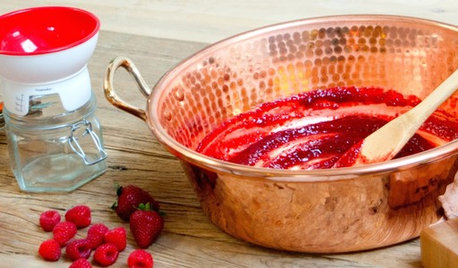Saving Tomato Seeds without Fermentation
trudi_d
15 years ago
Related Stories

EDIBLE GARDENSSummer Crops: How to Grow Tomatoes
Plant tomato seedlings in spring for one of the best tastes of summer, fresh from your backyard
Full Story
SHOP HOUZZHouzz Products: Save a Taste of Summer
Can't bear to part with the flavors of summer peaches, berries and tomatoes? Then jam on it!
Full Story
GREEN BUILDINGSunlight Used Right: Modern Home Designs That Harness Solar Power
Embracing passive heating principles through their architecture, siting and more, these homes save energy without skimping on warmth
Full Story
FEEL-GOOD HOMESimple Pleasures: 10 Ideas for a Buy-Less Month
Save money without feeling pinched by taking advantage of free resources and your own ingenuity
Full Story
FARM YOUR YARDHouzz Call: Home Farmers, Show Us Your Edible Gardens
We want to see where your tomatoes, summer squashes and beautiful berries are growing this summer
Full Story
GARDENING GUIDESCalifornia Gardener's June Checklist
Update your hydrangeas, catch up on tomatoes and more ways to enjoy your California garden in June
Full Story
SAVING WATERHouzz Call: Are You Letting Go of Your Lawn?
Many facing a drought are swapping turf for less thirsty plantings. If you’re one of them, we’d like to hear about it
Full Story
LANDSCAPE DESIGN15 Great Ideas for a Lawn-Free Yard
End the turf war for good with hardscaping, native grasses and ground covers that save water and are easier to maintain
Full Story
GREAT HOME PROJECTSHow to Replace Your Lawn With a Garden
New project for a new year: Lose the turfgrass for energy savings, wildlife friendliness and lower maintenance
Full Story
BEFORE AND AFTERSSee 6 Yards Transformed by Losing Their Lawns
Wondering whether a turf lawn is the best use of your outdoor space? These homeowners did, and they found creative alternatives
Full Story


containerted
trudi_dOriginal Author
Related Discussions
Fermentation: Which veggies?? Seed saving books??
Q
Tomato seeds not fermenting
Q
still some "goo" on Tomato seeds after fermentation
Q
Fermentation: Which veggies?? Seed saving books??
Q
colokid
trudi_dOriginal Author
colokid
trudi_dOriginal Author
nandina
trudi_dOriginal Author
trudi_dOriginal Author
tomatogreenthumb
trudi_dOriginal Author
sautesmom Sacramento
glitterglass
trudi_dOriginal Author
oregon_veg
trudi_dOriginal Author
mule
trudi_dOriginal Author
colokid
containerted
trudi_dOriginal Author
k2marsh
trudi_dOriginal Author
digdirt2
oregon_veg
k2marsh
mule
trudi_dOriginal Author
MrsJustice
trudi_dOriginal Author
irish_rose_grower
trudi_dOriginal Author
ddsack
containerted
trudi_dOriginal Author
containerted
trudi_dOriginal Author
brokenbar
trudi_dOriginal Author
colokid
trudi_dOriginal Author
cindeea